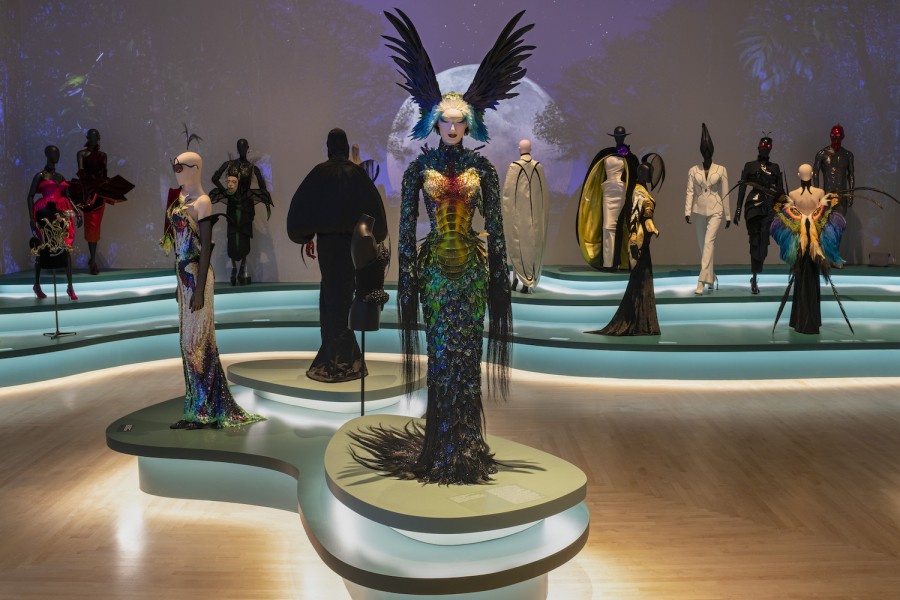Enter the world of Mugler with ‘Thierry Mugler: Couturissime’
The Brooklyn Museum’s exhibition highlights the transformative career of French designer Thierry Mugler.
The Brooklyn Museum’s display honors Thierry Mugler’s six-decade career of fashion design and perfumery. (Photo by Danny Perez, Courtesy of the Brooklyn Museum)
January 31, 2023
Rooms filled with mannequins adorned with archival pieces, fragrance bottles encased in glass and immersive visuals are only a fraction of the Brooklyn Museum’s “Thierry Mugler: Couturissime.” The retrospective exhibit honors French fashion designer Thierry Mugler and reflects on his illustrious six-decade-long career.
The exhibit’s first section consists of a dimmed room featuring Mugler’s robes à la française — or court dresses — from the 1985 staging of Shakespeare’s Macbeth by the Comédie-Française. In the center of the room, multimedia artist Michel Lemieux’s 2019 video “The Disappearance of Lady Macbeth” plays.
Further into the exhibition, mannequins dressed in plexiglass and molded metal from the designer’s Fall 1995 Couture Collection introduce viewers to Mugler’s “glamazon” — a woman who embraces their sexuality by wearing clothes made of unorthodox materials and structured silhouettes. His previous Spring/Summer 1994 ready-to-wear collection featured a leather crinoline dress, and his Spring/Summer 1998 couture collection included a crepe georgette draped gown. Both were hung using metal faux piercings.
Mugler’s designs were heralded in the realms of high fashion and pop culture both. Singer-songwriters, photographers and visual artists alike have celebrated Mugler’s designs in their personal pursuits, which are featured in the preceding section of the exhibit. The bold works of fashion photographers Helmut Newton, David LaChapelle and Ellen von Unwerth immortalize Mugler’s architectural and avant-garde instincts, highlighting his emphasis on construction.
The retrospective also presents music videos that feature the designer’s work, namely David Bowie’s 1979 “Boys Keep Swinging,” in which Bowie dons a sequined Mugler dress, and George Michael’s 1992 “Too Funky,” which Mugler scripted, directed and produced. Michael’s video features models lip-syncing his song while embodying what could be called Mugler-ism — an audacious yet fashionable approach to life.
Later in his career, Mugler went beyond fashion, experimenting with the art of perfumery. He launched his first fragrance “Angel” in 1992 and finished with “Aura’” in 2017. In a section of the exhibit dedicated to Mugler’s perfumes, a canopy of crystals looms above the display to create a dazzling showcase of jewels.
Another room of the exhibition displays an iconic gold, metal corset — worn by both Beyoncé in her 2009 music video “Sweet Dreams” and Celine Dion during a photoshoot in 2020 — from Mugler’s Fall 1995 Couture Collection. Other pieces surrounding the corset are made up of materials including metal, chrome car parts, latex and glass, weaving in traces of Franz Kafka’s “Metamorphosis” throughout their design.
This exhibition unveils an extensive public showcase of Mugler’s archive for the first time since each collection’s runway debut and includes over 100 outfits. The theme of metamorphosing into one’s desired self is realized with the changing shapes and sourced materials of Mugler’s creations. Mugler believed seduction and beauty are instinctual, and folded his love for art and women into fabric to give people a means to reinvent themselves.
Contact Jadah Jules at [email protected].
























































































































































